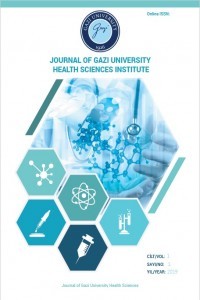Formulation Development Studies of Three-Dimensional Printable Filaments Containing Eudragit S100 Polymer with High-Glass Transition Temperature
Formulation Development Studies of Three-Dimensional Printable Filaments Containing Eudragit S100 Polymer with High-Glass Transition Temperature
Three-dimensional printing, Fused-deposition modelling Hot-melt extrusion, Eudragit S100, Filament,
___
- Beck, R.C.R., Chaves, P.S., Goyanes, A., Vukosavljevic, B., Buanz, A., Windbergs, M., et al. (2017) 3D printed tablets loaded with polymeric nanocapsules: An innovative approach to produce customized drug delivery systems. International Journal of Pharmaceutics, 528(1-2),268-79.
- Bruce, L.D., Shah, N.H., Malick, A.W., Infeld, M.H., McGinity, J.W. (2005). Properties of hot-melt extruded tablet formulations for the colonic delivery of 5-aminosalicylic acid. European Journal of Pharmaceutics and Biopharmaceutics, 59(1),85-97.
- Carlier, E., Marquette, S., Peerboom, C., Denis, L., Benali, S., Raquez, J.M. et al. (2019). Investigation of the parameters used in fused deposition modelling of poly (lactic acid) to optimize 3D printing sessions. International Journal of Pharmaceutics, 565,367-77.
- Chai, X.Y., Chai, H.Y., Wang, X.Y., Yang, J.J., Li, J., Zhao, Y., et al. (2017) Fused Deposition Modelling (FDM) 3D Printed Tablets for Intragastric Floating Delivery of Domperidone. Scientific Reports,7.
- Elkasabgy, N.A., Mahmoud, A.A., Maged, A. (2020). 3D printing: An appealing route for customized drug delivery systems. International Journal of Pharmaceutics, 588.
- Genina, N., Hollander, J., Jukarainen, H., Makila, E., Salonen, J., Sandler, N. (2016). Ethylene vinyl acetate (EVA) as a new drug carrier for 3D printed medical drug delivery devices. European Journal of Pharmaceutical Sciences, 90,53-63.
- Gioumouxouzis, C.I., Chatzitaki, A.T., Karavasili, C., Katsamenis, O.L., Tzetzis, D., Mystiridou, E. et al. (2018). Controlled Release of 5-Fluorouracil from Alginate Beads Encapsulated in 3D Printed pH-Responsive Solid Dosage Forms. AAPS PharmSciTech, 19(8),3362-75.
- Goyanes, A., Martinez, P.R., Buanz, A., Basit, A.W., Gaisford, S. (2015) Effect of geometry on drug release from 3D printed tablets. International Journal of Pharmaceutics, 494(2),657-63.
- Goyanes, A., Fina, F., Martorana, A., Sedough, D., Gaisford, S., Basit, A.W. (2017) Development of modified release 3D printed tablets (printlets) with pharmaceutical excipients using additive manufacturing. International Journal of Pharmaceutics, 527(1-2),21-30.
- Kollamaram, G., Croker, D.M., Walker, G.M., Goyanes, A., Basit, A.W., Gaisford, S. (2018) Low temperature fused deposition modelling (FDM) 3D printing of thermolabile drugs. International Journal of Pharmaceutics, 545(1-2),144-52.
- Okwuosa, T.C., Stefaniak, D., Arafat, B., Isreb, A., Wan, K.W., Alhnan, M.A. (2016) A Lower Temperature FDM 3D Printing for the Manufacture of Patient-Specific Immediate Release Tablets. Pharmaceutical Research, 33(11),2704-12.
- Okwuosa, T.C., Sadia, M., Isreb, A., Habashy, R., Peak, M., Alhnan, M.A. (2021) Can filaments be stored as a shelf-item for on-demand manufacturing of oral 3D printed tablets? An initial stability assessment. International Journal of Pharmaceutics, 600.
- Pereira, G.G., Figueiredo, S., Fernandes, A.I., Pinto, J.F. (2020). Polymer Selection for Hot-Melt Extrusion Coupled to Fused Deposition Modelling in Pharmaceutics. Pharmaceutics. 12(9).
- Pietrzak, K., Isreb, A., Alhnan, M.A. (2015) A flexible-dose dispenser for immediate and extended release 3D printed tablets. European Journal of Pharmaceutics and Biopharmaceutics, 96,380-7.
- Roulon, S., Soulairol, I., Lavastre, V., Payre, N., Cazes, M., Delbreilh, L. et al. (2021). Production of Reproducible Filament Batches for the Fabrication of 3D Printed Oral Forms. Pharmaceutics. 13(4).
- Sadia, M., Sosnicka, A., Arafat, B., Isreb, A., Ahmed, W., Kelarakis, A. (2016). Adaptation of pharmaceutical excipients to FDM 3D printing for the fabrication of patient-tailored immediate release tablets. International Journal of Pharmaceutics, 513(1-2), 659-68.
- ISSN: 2687-6353
- Yayın Aralığı: Yılda 3 Sayı
- Başlangıç: 2019
- Yayıncı: Gazi Üniversitesi
The Balance of Th17/Treg Cells at The Ocular Surface in Dry Eye Disease
Eman ALHARDODE, E. Ümit BAĞRIAÇIK
Berrin GÜNAYDIN, İrfan GÜNGÖR, Damlasu Selcen MURATOĞLU, Beyza Mehri BÜYÜKGEBİZ, Nuray BOZKURT
Cennet DURAN, Diren SARISALTIK YAŞIN, Sevgi TAKKA
Age-related Macular Degeneration and Current Therapies
Pakize Nur AKKAYA, Zohreh HOSSEINZADEH, Çiğdem ELMAS, Ayse SAHABOGLU
